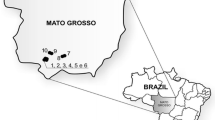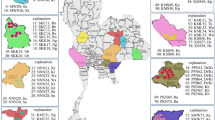Abstract
This study focuses on the genetic diversity of the cassava (Manihot esculenta Crantz) grown by the Chibchan Amerindians of Costa Rica. The authors collected cassava in various locations within two Amerindian Reserves: Talamanca, inhabited by Cabecares and Bribris, and Coto Brus, inhabited by Guaymi. Through the use of isozyme electrophoretic techniques we found variation for six out of nine systems analyzed, namely DIA, EST, IDH, MDH, PGI, and SKD. No variation was found in ADH, PGD, and PGM systems. We analyzed the distribution of variation within and between the reserves, and found most of the variation occurred within reserves (Gst = 0.1084). Only low levels of genetic differentiation were found between reserves (Nei’s genetic distance = 0.0088). The high levels of genetic variation within reserves that we found concur with results of previous studies on cassava grown by South American Amerindians and farmers. The role of the breeding system of cassava and the agricultural practices of Amerindians in the maintenance of high levels of genetic diversity are discussed.
Similar content being viewed by others
Literature Cited
Alcorn, J. B. 1981. Huastec noncrop resource management: Implications for prehistoric rain forest management. Human Ecology 9:395–417.
Altieri, M., L. C. Merrick, andM. K. Anderson. 1987. Peasant agriculture and the conservation of crop and wild plant resources. Conservation Biology 1:49–58.
Barrantes, R. 1993. Evolución en el trópico: Los amerindios de Costa Rica y Panamá. Editorial de la Universidad de Costa Rica, San Jose.
Beckerman, S. 1983a. Barí swidden gardens: Crop segregation patterns. Human Ecology 11:85–101.
Beckerman, S. 1983b. Does the swidden ape the jungle? Human Ecology 11:1–12.
Bellon, M. 1991. The ethnoecology of maize variety management: A case study from Mexico. Human Ecology 19: 389–418.
Bellon, M. 1996. The dynamics of crop infraspecific diversity: A conceptual framework at the farmer level. Economic Botany 50:26–39.
Bellon, M., andS. B. Brush. 1994. Keepers of maize in Chiapas, Mexico. Economic Botany 48:196–209.
Best, R., andG. Henry. 1994. Cassava: Towards the year 2000. Pages 18–23 in International Network for Cassava Genetic Resources. Report of the First Meeting of the International Network for Cassava Genetic Resources, CIAT, Cali, Colombia, 18–23 August 1992. International Crop Network Series No. 10. International Plant Genetic Resources Institute, Rome, Italy.
Borge, C., andCastillo, R. 1997. Cultura y conservación en la Talamanca Indígena. Editorial Uned, San Jose, Costa Rica.
Boster, J. S. 1985. Selection for perceptual distinctiveness: Evidence from Aguaruna cultivars ofManihot esculenta. Economic Botany 39:310–325.
Brush, S. B. 1992. Reconsidering the green revolution: Diversity and stability in cradle areas of crop domestication. Human Ecology 20:145–167.
Brush, S. 1989. Rethinking crop genetic resource conservation. Conservation Biology 3:19–29.
Brush, S. 2000. Genes in the field: On farm conservation of crop diversity. International Development Centre and International Plant Genetic Resources Institute. Lewis Publishers.
Camacho, C. 1996. En la frontera del siglo XX. La exclusión de los guaymíes en Costa Rica. Publicaciones Universidad de Costa Rica, San Jose.
Chavarriaga-Aguirre, P., M. M. Maya, M. W. Bonierbale, S. Kresovich, M. A. Fregene, J. Tohme, andG. Kochert. 1998. Microsatellites in cassava (Manihot esculenta Crantz): Discovery, inheritance and variability. Theoretical and Applied Genetics 97:493–501.
Chavarriaga-Aguirre, P., M. M. Maya, J. Tohme, M. C. Duque, C. Iglesias, M. W. Bonierbale, S. Kresovich, andG. Kochert. 1999. Using microsatellites, isozymes and AFLPs to evaluate genetic diversity and redundancy in the cassava core collection and to assess the usefulness of DNA-based markers to maintain germplasm collections. Molecular Breeding 5:263–273.
Cheliak, W. M., andJ. A. Pitel. 1984. Techniques for starch gel electrophoresis of enzymes from forest tree species. Agriculture Canada, Canadian Forestry Service, Petawana National Forestry Institute, Info Report PI-X-42. 49 p.
Fregene, M., J. Vargas, J. Ikea, F. Angel, J. Tohme, R. A. Asiedu, M. O. Akoroda, andW. M. Roca. 1994. Variability of chloroplast DNA and nuclear ribosomal DNA in cassava (Manihot esculenta Crantz). Theoretical and Applied Genetics 89:719–727.
Gordon, B. L. 1983. A Panama forest and shore. Natural history and Amerindian culture in Bocas del Toro. The Boxwood Press, California.
Guevara, M., andChacon, R. 1992. Territories indios en Costa Rica: Origen, situación actual y perspectivas. García Hnos., San Jose, Costa Rica.
Gulick, P., C. Hershey, andJ. E. Alcazar. 1983. Genetic resources of Cassava and wild relatives. International Board for Plant Genetic Resources, Rome.
Hamrick, J. L., andM. D. Loveless. 1986. Isozyme variation in tropical trees: Procedures and preliminary results. Biotropica 18:201–207.
Harris, H., andD. A. Hopkinson. 1976. Handbook of enzyme electrophoresis in human genetics. North Holland Publishing Co., Oxford.
Hershey, C. 1994.Manihot genetic diversity. Pages 111–134 in International Network for Cassava Genetic resources. Report of the First Meeting of the International Network for Cassava Genetic Resources, CIAT, Cali, Colombia, 18–23 August 1992. International Crop Network Series No. 10. International Plant Genetic Resources Institute, Rome, Italy.
Hodel, U., andM. Gessler. 1999. In situ conservation of plant genetic resources in homegardens of Southern Vietnam. A report of homegarden surveys in Southern Vietnam, December 1996–May 1997. International Plant Genetic Resources Institute, Rome, Italy.
Hussain, A., W. Bushuk, H. Ramirez, andW. Roca. 1987. Identification of cassava (Manihot esculenta Crantz) cultivars by electrophoretic patterns of esterase isozymes. Seed Science and Technology 15: 19–22.
Lambert, D. P. 1996. Crop diversity and fallow management in a tropical deciduous forest shifting cultivation system. Human Ecology 24:427–453.
Lamont, S. R., W. H. Esbaugh, andA. M. Greenberg. 1999. Species composition, diversity, and use of homegardens among three Amazonian villages. Economic Botany 53:312–326.
Lefevre, F., andA. Charrier. 1993. Isozyme diversity within AfricanManihot germplasm. Euphytica 66:73–80.
Mitton, J. B., Y. B. Linhart, B. K. Sturgeon, andJ. L. Hamrick. 1979. Allozyme polymorphism detected in mature needle tissue of Ponderosa Pine. Journal of Heredity 70:86–89.
Padoch, C., andW. de Jong. 1991. The house gardens of Santa Rosa: Diversity and variability in an Amazonian agricultural system. Economic Botany 45:166–175.
Ramirez, H., A. Hussain, W. Roca, andW. Bushuk. 1987. Isozyme electrophoregrams of sixteen enzymes in five tissues of cassava (Manihot esculenta Crantz) varieties. Euphytica 36:39–48.
Resende, A. G., P. S. V. Filho, andM. F. P. S. Machado. 2000. Isozyme diversity of cassava cultivars (Manihot esculenta Crantz). Biochemical Genetics 38:203–216.
Rico Gray, V., J. G. Garcia Franco, A. Chemas, A. Puch, andP. Sima. 1990. Species composition, similarity and structure of Mayan homegardens in Tixpeual and Tixcacaltuyub, Yucatan, Mexico. Economic Botany 44:470–487.
Roa, A. C., M. M. Maya, M. C. Duque, J. Tohme, A. C. Allem, andM. W. Bonierbale. 1997. AFLP analysis of the relationships among cassava and otherManihot species. Theoretical and Applied Genetics 95:741–750.
Rogers, D. J., andH. S. Flemming. 1973. Monograph ofManihot esculenta with an explanation of the taximetrics methods used. Economic Botany 27:1–114.
Salick, J., Celinesse, N., andS. Knapp. 1997. Indigenous diversity of cassava: generation, maintenance, use and loss among the Amuesha, Peruvian Upper Amazon. Economic Botany 51:6–19.
Sambatti, J. B. M., P. S. Martins, andA. Ando. 2001. Folk taxonomy and evolutionary dynamics of cassava: a case study in Ubatuba, Brazil. Economic Botany 55:93–105.
Soltis, D. E., andP. S. Soltis. 1989. Isozymes in plant biology. Dioscorides Press, U.S.A.
Vargas, J. L. 1990. Prácticas agrícolas sostenibles en áreas de bosque Tropical húmedo en Costa Rica. Geoitsmo 4:1–94.
Wendel, J. F., andN. F. Wendel. 1989. Visualization and interpretation of plant isozymes. Pages 5–45 in D. E. Soltis and P. S. Soltis, eds., Isozymes in plant biology. Dioscorides Press, U.S.A.
Weir, B. S., andC. C. Cockerham. 1984. Estimating F-statistics for the analysis of population structure. Evolution 38:1358–1370.
Yeh, F. C., R. Yang, andT. Boyle. 1999. Popgene version 1.31: Microsoft Windows-based freeware for population genetic analysis. University of Alberta, Edmonton, Canada.
Young, P. D. 1971. Ngawbe. Tradition and change among the Western Guaymi of Panama. University of Illinois Press, Urbana.
Zaldivar, M. E., O. J. Rocha, E. Castro, andR. Barrantes. 2002. Species diversity of edible plants grown in homegardens of Chibchan Amerindians from Costa Rica. Human Ecology 30: 301–316.
Author information
Authors and Affiliations
Rights and permissions
About this article
Cite this article
Zaldivar, M.E., Rocha, O.J., Aguilar, G. et al. Genetic variation of cassava (Manihot esculenta Crantz) cultivated by Chibchan Amerindians of Costa Rica. Econ Bot 58, 204–213 (2004). https://doi.org/10.1663/0013-0001(2004)058[0204:GVOCME]2.0.CO;2
Received:
Accepted:
Issue Date:
DOI: https://doi.org/10.1663/0013-0001(2004)058[0204:GVOCME]2.0.CO;2




